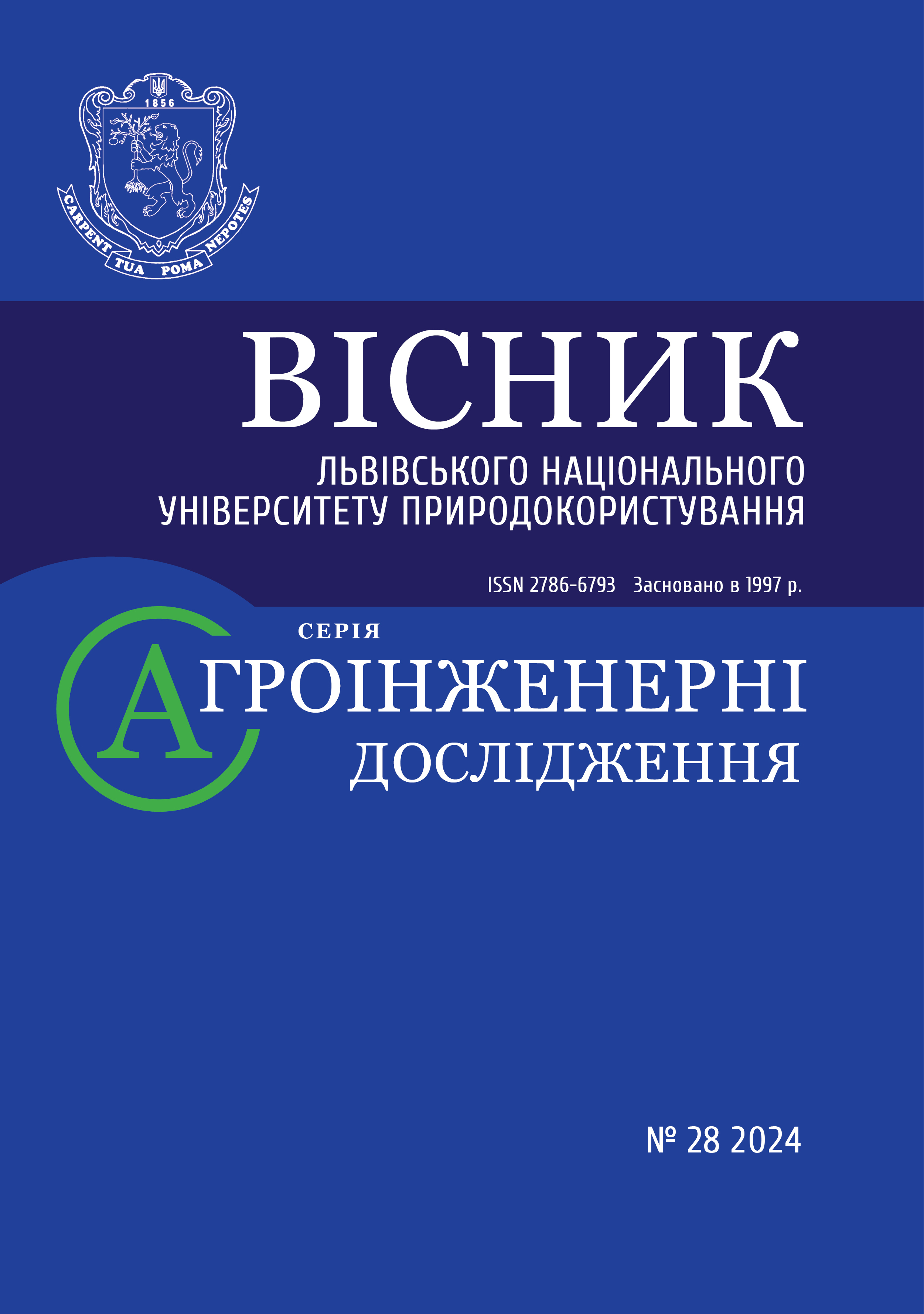Дослідження коефіцієнтів зчеплення та опору коченню автомобільних шин
DOI:
https://doi.org/10.31734/agroengineering2024.28.070Ключові слова:
тяговий пристрій, коефіцієнт опору коченню, коефіцієнт зчеплення коліс, програмний модульАнотація
Для визначення тягово-зчіпних показників автомобілів, зокрема коефіцієнтів опору коченню і зчеплення автомобілів, широко використовується спосіб буксирування, який може реалізуватись доволі простим пристроєм, оснащеним горизонтально розташованим динамометром та гнучким буксирним пасом. Вказаний спосіб характеризується великою похибкою визначення середнього зусилля буксирування, яке зумовлене мінливістю взаємодії колісних рушіїв з опорною поверхнею і, відповідно, низькою точністю визначення способом буксирування як коефіцієнта зчеплення з опорною поверхнею, так і інших тягово-зчіпних показників, зокрема коефіцієнта опору коченню.
Стандартний тяговий пристрій для визначення тягово-зчіпних властивостей мобільних енергетичних засобів характеризується значним елементарним інтервалом вимірювання ∆tді, який обмежений можливістю людини візуально спостерігати і реєструвати поточні покази динамометра. Значний елементарний інтервал ∆tді спричиняє низьку точність визначення зусилля буксирування й відповідно середнього значення сили, коефіцієнта опору коченню та зчеплення. Це зумовлено зміною показів динамометра зі значною швидкістю через мінливість мікропрофілю дороги. Тому візуальний спосіб спостереження під час досліджень вкрай неточний.
Розроблено методику та програмний комплекс для підвищення точності визначення зусилля буксирування мобільних енергетичних засобів, яка забезпечується зменшенням елементарного інтервалу реєстрації значень вимірювання. Запропонований програмний модуль приєднується до силової тензоланки електронного динамометра. Модуль представлений у вигляді мікросхеми з аналогово-цифровим перетворювачем, що з’єднується через мікроконтролер з шиною підключення зовнішніх пристроїв та інтерфейс виводу даних. Така архітектура модуля забезпечує передачу даних на електронний носій інформації ‑ карту пам’яті чи персональний комп’ютер.
Визначено коефіцієнти опору коченню та зчеплення коліс Debica Passio 2 175/70 R13 82T автомобіля ЗАЗ Sens для різних типів опорної поверхні. Встановлено, що для асфальтованої дороги значення φі перебуває в межах 0,6914…0,7162 із середнім значенням 0,698. Для ґрунтової дороги значення φі перебуває в межах 0,5754…0,6144 із середнім значенням 0,595. Для гравійної ділянки дороги значення коливаються в межах 0,3755…0,4451 із середнім значенням 0,408. Найменші значення φі отримано для мокрої ґрунтової дороги – 0,3275…0,3768 із середнім значенням 0,358.
Для зимових шин коефіцієнт зчеплення для асфальтованої дороги φі є в межах 0,6138…0,6514 із середнім значенням 0,6280. Для ґрунтової дороги значення φі ‑ 0,5799…0,6045 із середнім значенням 0,5919. Для гравійної ділянки дороги значення коливаються в межах 0,3847…0,4041 із середнім значенням 0,3945. Більші порівняно з літніми шинами значення φі отримано для мокрої ґрунтової дороги – 0,3761…0,3908 із середнім значенням 0,3825.
Посилання
Denton, T. (2018). Automobile mechanical and electrical systems. New York: Routledge.
Makarov, V. A. (2013). Modeliuvannia rukhu avtomobilia z urakhuvanniam tiahovoi syly y pererozpodilu masy. Avtomobilnyi transport, 32, 23-28.
Marmut, I. A., Kashkanov, V. A., & Zuiev, V. O. (2020). Eksperymentalne doslidzhennia oporu kochennia kolis avtomobilia na rolykovomu stendi. Visnyk mashynobuduvannia ta transportu, 2 (12), 68-75.
Open Source Arduino Learner Kit V2. (2023). Retrieved from https://www.instructables.com/Open-Source-Arduino-Learner-Kit-V2/.
Pacejka, H. B. (2002). Tyre Mechanics and Vehicle Dynamics. Oxford, UK: Butterworth-Heinemann.
Podryhalo, M. A., Volkov, V. P., & Boboshko, V. P. (2008). Dynamika avtomobilia. Kharkiv: KhNADU.
Sakhno, V. P., Verbytskyi, V. H., Kostenko, A. V., Belevtsova, N. L., & Yefymenko, A. M. (2010). Vplyv stabilizuiuchoho momentu shyn na kursovu stiikist rukhu avtomobilia. Visnyk Natsionalnoho transportnoho universytetu, 21 (1), 180-183.
Shevchuk, R. S. (2018). Ekspluatatsiini pokaznyky traktoriv i avtomobiliv: praktykum z rozrakhunku pokaznykiv. Lviv: Lvivskyi natsionalnyi ahrarnyi universytet.
Shevchuk, R. S., Shevchuk, V. V., & Sukach, O. M. (2023). Pat. № 154291 Ukraina, MPK G01M 17/02 (2006.01). №u 202301569; zaiavl. 10.04.2023; opubl. 01.11.2023, Biul. № 44.
Shevchuk, R. S., Sukach, O. M., & Shevchuk, V. V. (2019). Pat. № 138538 Ukraina, MPK G01M 17/02. №u201904631; zaiavl. 12.06.2019; opubl. 25.11.2019, Biul. № 22.
Shevchuk, R. S., Sukach, O. M., & Shevchuk, V. V. (2023). Modernizovanyi prystrii dlia vyznachennia tiahovo-zchipnykh pokaznykiv mobilnykh enerhetychnykh zasobiv. Problemy konstruiuvannia, vyrobnytstva ta ekspluatatsii silskohospodarskoi tekhniky: materialy XIV Mizhnar. nauk.-prakt. konf. 2023. Kropyvnytskyi: TsNTU.
Tsyrulnyk, S. M. (2021). Prohramno-aparatnyi kompleks “Arduino leaner kit”. Vidkryte osvitnie e-seredovyshche suchasnoho universytetu: elektronne naukove fakhove vydannia, 10, 231-240.
Tyshchenko, K. V., & Tkach, O. P. (2018). Prohramuvannia system zboru i analizu danykh: navch. posibnyk. Sumy: Sumskyi derzhavnyi universytet.
Vikovych, I. A. (2013). Teoriia rukhu transportnykh zasobiv: pidruchnyk. Lviv: Vydavnytstvo Lvivskoi politekhniky.
Volkov, V. P., & Vilskyi, H. B. (2010). Teoriia rukhu avtomobilia: pidruchnyk. Sumy: Universytetska knyha.


